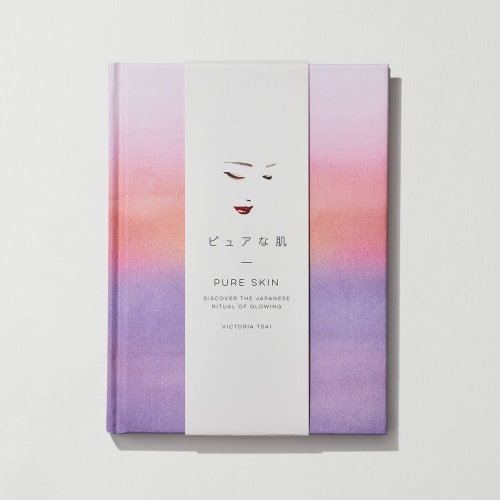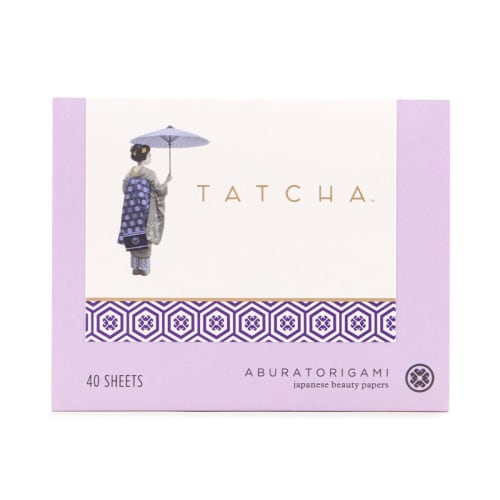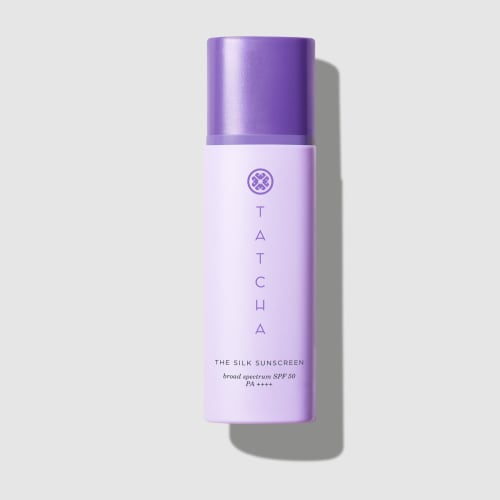For years, Tatcha has brought its expertise in Japanese skincare ingredients to faces all over the world. This guide will help you choose the Tatcha products that’ll most benefit your skin type.

Some beauty founders have dreams of grandeur, but that wasn’t exactly the case for Vicky Tsai—she just wanted to make products that worked for her skin.
So Tatcha was born: Not with a bang, but with a wish. Her career in finance kept her constantly on her feet, on her computer, or on a plane, until one day, she woke up to find her skin was reacting. “My entire face was covered with red, blistering, cracked, and scaling skin—not even my lips or eyelids were spared,” she wrote in her book Pure Skin. “I have always loved meeting new people, but during that time I withdrew from the world around me.
This experience sent her on a journey that began on a layover in Japan, when a friend introduced Tsai to special blotting papers—a product of Japanese craftsmanship and heritage with a long history of use. Tsai was told all about how blotting papers, and other inventions made from Japanese botanicals, have been used in skincare formulations throughout Japanese history. Geisha performers who wore heavy white makeup would use blotting papers and the oil of the camellia flower, or tsubaki, to keep their skin luminous and healthy between performances. In Kyoto, Tsai learned how to mix rice powder and camellia oil to make an exfoliating treatment. She went home, and within four weeks of using these skincare formulations, her dermatitis cleared up.
As soon as Tsai figured out a way to formulate with these cherished ingredients, Tatcha came to be. The brand was founded on the idea of providing efficacious skincare to all faces using Japanese botanicals in gentle but efficacious formulations. Of course, no two faces are the same, which is part of the reason why the brand’s collection has extended to accommodate all skin types: dry, normal, oily, sensitive, mature, or all of the above at one time or another.
Whatever your skin type, there’s a Tatcha routine for you. Now let’s figure out what that is.
What are the basics of skincare?
Every face, regardless of its skin type, needs just a few basic products in order to support its health and function.
The skin is the largest organ in the human body, responsible not only for keeping all of our other systems intact and protected from the outside world, but also for keeping bad stuff out. In fact, skin’s chief function is as a barrier. Ensuring the integrity of this barrier is the main goal of skincare.
There are a few ways we do this. Most dermatologists recommend a very simple regimen. The American Academy of Dermatologists Association outlines a simple skincare routine beginning by washing the skin (to cleanse), followed by a moisturizer (to seal the skin barrier), and then a sunscreen to protect from overexposure to ultraviolet rays.
Three products might be all you really need. But depending on the goals of your skin, you may also want to include other ingredients to balance skin’s oil and water content or just to add additional nourishment with powerful actives. Figuring out your unique skin type can help you get closer to the skincare routine that’s best for you
What’s my skin type?
Luckily, skin types are not too hard to parse out. The main ones describe your skin’s oil content, which can probably be observed in your mirror. When in doubt, a dermatologist can point you in the right direction. But if you’d like to first try to figure it out on your own, we at Tatcha recommend two simple tests.
The bare-face method. All you need to do is wash your face gently, pat it dry, wait 30 minutes, and inspect your face for signs of oil. Then wait another 30 minutes and check again. If your skin remains matte and unoiled, you probably have drier skin; if it gets oily immediately, you probably have oily skin; and if the oil is only local to some areas, you’re likely to have combination skin.
The blotting paper method. This one is a little easier, and only requires blotting paper. Take one sheet of paper, press it into your skin, and then hold it up to the light: The more translucent the paper is, the oilier you are; the more unaffected the paper is, the drier your skin is.
These two steps cover the main normal, oily, and dry skin types, but there are two others. They’re less easily observable, and yet you’ll probably know if you have them. Sensitive skin, for example, is more reactive than other skin types, and likely to refer to those who are battling breakouts more often than not. Mature skin describes skin that is displaying some of the first signs of aging, from wrinkles to hyperpigmentation.
What are the best Tatcha products for my skin type?
Once you’ve figured out your skin type, building a routine becomes an easier task. You already know the standard building blocks of skincare, and now you can tailor those steps to the needs of your unique skin type. Heed some of these product recommendations based on how oily, dry, combination, or sensitive your skin is.
For normal skin
The term “normal” is a bit of a misnomer here—skin that happens to be oily is just as normal an occurrence as skin that isn’t. But for the sake of the term, normal faces aren’t prone to an excess nor a dearth of face oil, but they also don’t often tend towards dryness. This skin type isn’t exempt from these conditions, but they occur less often.
Normal skin needs what every skin type needs: A cleanser, a moisturizer, and of course, a sunscreen. Overexposure to ultraviolet radiation not only can damage the skin and cause premature aging, but it’s also the number one risk factor for skin cancer. The SPF 50 Silk Sunscreen is suited for all skin types: A zinc oxide filter reflects the sun’s rays, while niacinamide and hyaluronic acid work in tandem to hydrate skin. It’s not just clutch for normal skin types, but for all skin types.
For oily skin
When we talk about “oil” in the context of skin, we’re usually talking about sebum, the waxy and essential substance that our skin naturally produces. Sebum is secreted by glands that are tucked within hair follicles, according to the Cleveland Clinic; this sebum is made up of some of the stuff that fortifies our skin barrier. When the skin produces too much sebum, it can cause acne.
The main goal of those with oily skin is simply to keep their oil levels in check, which is achievable using a variety of skincare products. Oily skin can benefit from an oil-controlling cleanser like Tatcha’s The Matcha Cleanse , a fragrance-free gel cleanser that purifies congested pores without stripping skin. But it can also benefit from updating your moisturizer to include ingredients that are shown to regulate skin’s oil content. Tatcha’s The Water Cream, for one example, is a gel formulated with oil-controlling floral extracts from wild rose and leopard lily. One plastic surgeon recommended the Water Cream to Allure magazine specifically for oily skin: “I love the transformation when you apply this hydrating, oil-free water cream.”
For dry skin
Dry skin isn’t exactly what it sounds like. Remember how the main skin types have to do with skin’s oil content? Dry skin is an absence of oil, or sebum, but not necessarily an absence of water. More so than normal or oily skin, dry skin can feel uncomfortable at times, even painful. Symptoms of dry skin can include tightness, thickening, or cracking—usually, dry skin feels rough to the touch. Risk factors for dry skin range, and include intrinsics like age and biology, as well as extrinsics like weather or occupation. (A potter is probably likelier than a typist to have dry skin on their hands because of the materials they handle.)
The goal of making dry skin less dry involves nourishing that ever-important skin barrier. Between cleansing and moisturizing, a face mist can help prime the skin for more moisture—Tatcha’s Luminous Dewy Skin Mist is a cult favorite infused with the brand’s signature skin complex. Other products that are lighter than creams in texture, like serums or essences, can be patted onto the skin for an extra burst of hydration.
But a rich skin cream will benefit dry skin types most of all, especially if it’s loaded with ingredients that have been shown to replenish the skin’s barrier. The Dewy Skin Cream is ideal for dry skin, but good for anybody who wants a little moisture boost: A special blend of Okinawa algae and hyaluronic acid captures water to help restore skin’s natural moisture reservoir.
For sensitive skin
Sensitive skin is a trickier skin type. Despite it’s prevalence—some studies suggest that half of a given population anywhere has sensitive skin, while lower rates have been observed in places where skin runs darker—it is more complicated than oily or dry skin.
Sensitive skin is characterized by “epidermal dysfunction,” or a higher rate of skin reactions and breakouts when compared to other skin types. These sorts of reactions can range in their expressions, from dryness to redness to full-blown rashes. They’re usually not difficult to spot when they arrive, and frequently, they’re caused by reactions to potentially irritating stimuli, like the weather, or pollution, or sun exposure, or skincare products.
Whereas adding products to one’s routine might be advantageous for another skin type, it can be riskier for the sensitive skinned, who may be more cautious about trying new things. If it helps, try thinking less about products and more about ingredients. There have been plenty of ingredients shown to calm down reactive skin—some of them, like Japanese indigo, are are medicinal botanicals that have long histories of use. (During the Edo period in Japan, Samurais wore a layer of indigo-dyed cotton beneath their armor to help heal injuries.) Indigo contains tryptanthrin, known to help flush away toxins and irritants, and indirubin, which supports the skin’s natural barrier function. Tatcha uses Japanese indigo and its powerful natural compounds for its sensitive skin formulations, like in the butter-soft Indigo Cleansing Balm and the soothing Indigo Calming Face Cream. It’s even earned acceptance from the National Eczema Association.
For mature skin
Unlike any other skin type, mature skin happens to every single one of us, and might be the one skin type that everybody has eventually. Towards your late 30s and early 40s, the signs of aging begin to appear. Skin loses volume and elasticity and wrinkles and age spots begin to emerge.
In Japan, aging is viewed as a gift, rather than something to dread. The goal is not to look baby-young but to have healthy-looking skin at any age. Some of the most important aspects of promoting skin health could be categorized as everyday healthy living—not smoking, limiting stress, eating a nourishing diet. The impetus for wearing sunscreen only gets more powerful as you age and your risk of skin cancer increases.
There are other considerations for mature skin, too. First, make sure you choose a cleanser that doesn’t tug on your skin or dry you out. (Tatcha’s two-in-one Camellia Cleansing Oil is a fabulous choice—its featherweight texture mimics the skin barrier, and moisturizes while it washes.) As our skin has difficulty holding on to nourishment as we age, it’s a wise idea to bolster your barrier with nourishing ingredients, like those distilled in the Ageless Enriching Renewal Cream. In addition to providing superior moisture, it also includes botanicals like peony flower and gardenia fruit extract that help address the loss of elasticity and diminish the appearance of fine lines and wrinkles.
Mature faces might also enjoy incorporating products that bring these powerful ingredients to the areas of our skin that need it most or are sometimes neglected. Enter the Ageless Revitalizing Eye Cream and Neck Cream, both of which tout firming as a chief benefit to make up for elasticity lost to age. The skincare market is huge, with plenty of options for every single skin benefit you could think of. By identifying your skin type, you can narrow them down to the ones that work for you.













